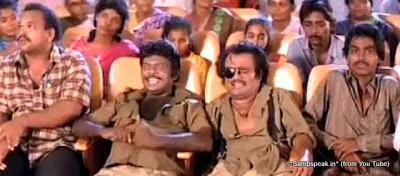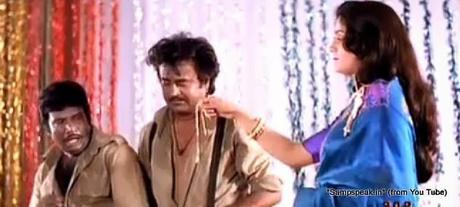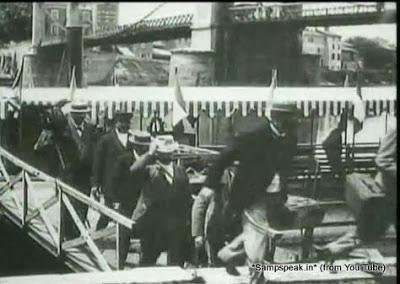

Rajnikant, Vijayashanti starrer Mannan released in 1992 was a great hit. It was a remake of the 1986 hit Kannada film Anuraga Aralithu starring Rajkumar. In one of the scenes, Rajni and Goundamani would take leave from factory on a false pretext, stand in queue buying ticket for Chinna Thambi on its 175th day…. the 1st man was to receive a gold chain and the 2nd a golden ring….. winners Rajni and Goundamani would be startled as the prizes would be given in the hands of Vijayashanthi, to whom they had lied and had come to the movie……..
 One thing that could perhaps puzzle economists is the non-applicability of ‘demand and supply’…….. the relatively strong uniformity of movie ticket prices – even where the manufacturing cost and the salary of artisans vastly differ……yet the prices of a star movie and unknown stock do not ordinarily vary…..which is not so in other forms of entertainments such as starnite, rock concerts … film awards and the like… more the hype – more the price one will have to cough !! Ever seen a film in ‘Touring talkies’…….. or in a village … there will be tharai ticket (sitting on the ground) and bench ticket ~ if you are somebody, as one enters, the owner (or the manager) would come, offer you a seat by cleaning that bench with the towel that one has on the shoulder… !! ~ a dog or rat would run in between the legs suddenly… and after a few reels, the movie would be stopped and lights put on – to enable changing the reels of the film….. Raja Harishchandra released in 1913 was the first film – a silent movie, directed and produced by Indian icon Dadasaheb Phalke. The film on the legend Harischandra, who spoke only truth, marked a historic benchmark in the film industry in India. Only one print of the film was made and shown at the Coronation Cinematograph. Not lacking behind was Tamil (why language in a silent movie !?!) - Keechaka Vadham, made by R. Nataraja Mudaliar in 1916. The first talkie was a multi-lingual Kalidas which released on 31 October 1931, barely 7 months after India's first talking picture Alam Ara. Films have been there for more than a century now and the history can be traced to the invention of the movie camera itself. Most films before 1930 were silent ~ this is no post on the tinseldom and the growth of Actors and actresses nor their capturing governance ….it is more about the ticket – the cinema ticket that commoners buy to watch a movie. The Lumière brothers were born in Besançon, France, and moved to Lyon. Their father, Claude-Antoine Lumière (1840–1911), ran a photographic firm and both brothers worked for him: Louis as a physicist and Auguste as a manager. They patented a number of significant processes leading up to their film camera, most notably film perforations as a means of advancing the film through the camera and projector. Ever since brothers Louis and Auguste Lumiere screened the first program of films to a paying audience at Paris' Grand Cafe in 1895, the French have viewed film as an art form to be protected from the worst excesses of crass commercialism.
One thing that could perhaps puzzle economists is the non-applicability of ‘demand and supply’…….. the relatively strong uniformity of movie ticket prices – even where the manufacturing cost and the salary of artisans vastly differ……yet the prices of a star movie and unknown stock do not ordinarily vary…..which is not so in other forms of entertainments such as starnite, rock concerts … film awards and the like… more the hype – more the price one will have to cough !! Ever seen a film in ‘Touring talkies’…….. or in a village … there will be tharai ticket (sitting on the ground) and bench ticket ~ if you are somebody, as one enters, the owner (or the manager) would come, offer you a seat by cleaning that bench with the towel that one has on the shoulder… !! ~ a dog or rat would run in between the legs suddenly… and after a few reels, the movie would be stopped and lights put on – to enable changing the reels of the film….. Raja Harishchandra released in 1913 was the first film – a silent movie, directed and produced by Indian icon Dadasaheb Phalke. The film on the legend Harischandra, who spoke only truth, marked a historic benchmark in the film industry in India. Only one print of the film was made and shown at the Coronation Cinematograph. Not lacking behind was Tamil (why language in a silent movie !?!) - Keechaka Vadham, made by R. Nataraja Mudaliar in 1916. The first talkie was a multi-lingual Kalidas which released on 31 October 1931, barely 7 months after India's first talking picture Alam Ara. Films have been there for more than a century now and the history can be traced to the invention of the movie camera itself. Most films before 1930 were silent ~ this is no post on the tinseldom and the growth of Actors and actresses nor their capturing governance ….it is more about the ticket – the cinema ticket that commoners buy to watch a movie. The Lumière brothers were born in Besançon, France, and moved to Lyon. Their father, Claude-Antoine Lumière (1840–1911), ran a photographic firm and both brothers worked for him: Louis as a physicist and Auguste as a manager. They patented a number of significant processes leading up to their film camera, most notably film perforations as a means of advancing the film through the camera and projector. Ever since brothers Louis and Auguste Lumiere screened the first program of films to a paying audience at Paris' Grand Cafe in 1895, the French have viewed film as an art form to be protected from the worst excesses of crass commercialism.  France is credited to be the birthplace of cinema and was responsible for many of its early significant contributions. Several important cinematic movements, began here. ‘Workers Leaving The Lumière Factory in Lyon’ (French: La Sortie des usines Lumière à Lyon), also known as Employees Leaving the Lumière Factory and Exiting the Factory, is an 1895 French short black-and-white silent documentary film directed and produced by Louis Lumière. It is often referred to as the first real motion picture ever made. The film consists of a single scene in which workers leave the Lumiere factory. The workers are mostly female who exit the large building 25 rue St. Victor, Montplaisir on the outskirts of Lyon, France, as if they had just finished a day's work. Three separate versions of this film exist and there are a number of differences between them.
France is credited to be the birthplace of cinema and was responsible for many of its early significant contributions. Several important cinematic movements, began here. ‘Workers Leaving The Lumière Factory in Lyon’ (French: La Sortie des usines Lumière à Lyon), also known as Employees Leaving the Lumière Factory and Exiting the Factory, is an 1895 French short black-and-white silent documentary film directed and produced by Louis Lumière. It is often referred to as the first real motion picture ever made. The film consists of a single scene in which workers leave the Lumiere factory. The workers are mostly female who exit the large building 25 rue St. Victor, Montplaisir on the outskirts of Lyon, France, as if they had just finished a day's work. Three separate versions of this film exist and there are a number of differences between them.  28th Dec 1895 was landmark in cinema history for this is considered to be the day on which Lumiere brother’s movie was screened at Grand Café in Paris commercially for the first time…. that is tickets were sold to public and people watched the show paying for it…… how much things have moved now is best understood by the way box office reviews write of film grossing so many crores… In modern French film industry understand that there is something called ‘carte illimitee’, an unlimited-access pass offered by the country's biggest cinema chain, Union Generale Cinematographique (UGC). The pass, available for an annual subscription paid in monthly installments of $14, was introduced by UGC in March as part of a marketing push to get more people into its 43 cinemas. Chairman Guy Verecchia told French daily Le Monde at the time that "if French people went to the cinema as frequently as Spaniards do, we would sell 200 million tickets a year. Next time you stand in a queue for a movie ticket – praise or curse Lumiere brothers..
28th Dec 1895 was landmark in cinema history for this is considered to be the day on which Lumiere brother’s movie was screened at Grand Café in Paris commercially for the first time…. that is tickets were sold to public and people watched the show paying for it…… how much things have moved now is best understood by the way box office reviews write of film grossing so many crores… In modern French film industry understand that there is something called ‘carte illimitee’, an unlimited-access pass offered by the country's biggest cinema chain, Union Generale Cinematographique (UGC). The pass, available for an annual subscription paid in monthly installments of $14, was introduced by UGC in March as part of a marketing push to get more people into its 43 cinemas. Chairman Guy Verecchia told French daily Le Monde at the time that "if French people went to the cinema as frequently as Spaniards do, we would sell 200 million tickets a year. Next time you stand in a queue for a movie ticket – praise or curse Lumiere brothers..With regards – S. Sampathkumar

